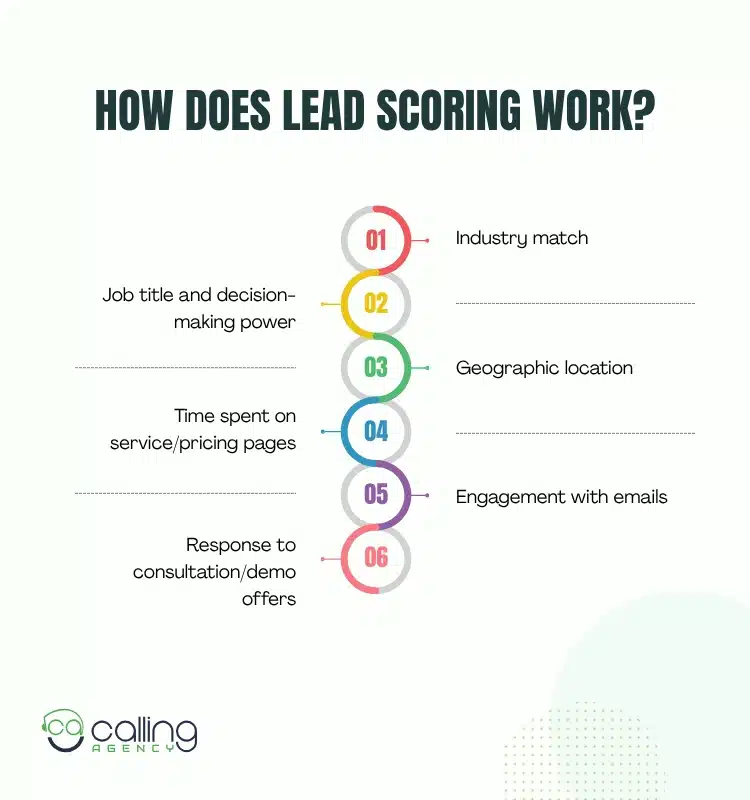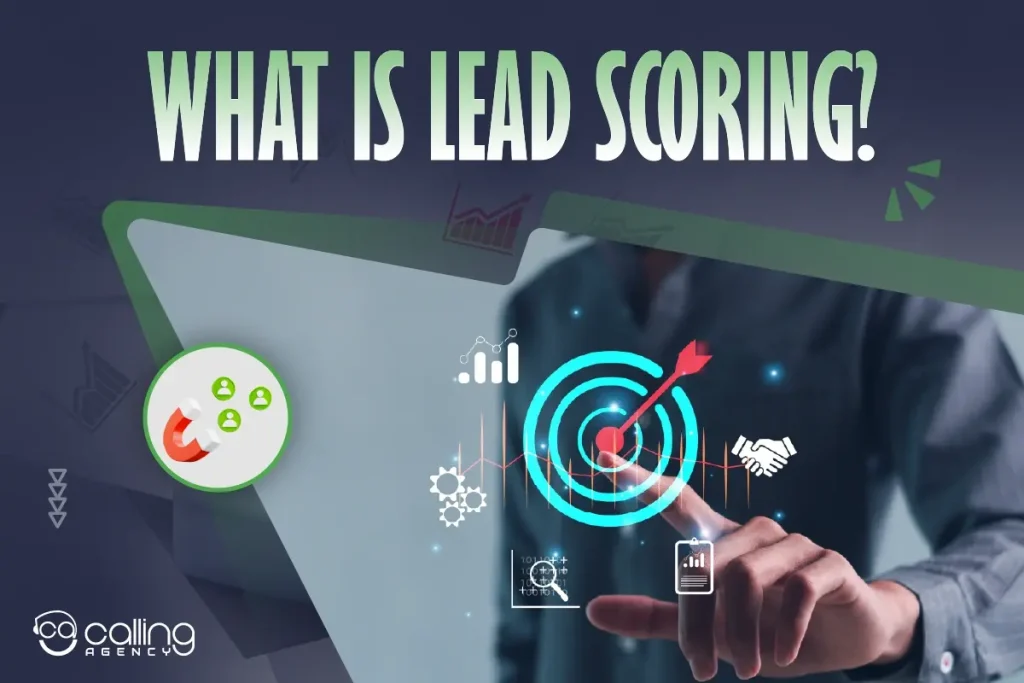Lead scoring is a process that ranks each lead based on its potential to become a customer or make a purchase. Lead scoring helps you work smarter, not harder, because if you try on a lead that is less likely to buy something, then you are wasting your time.
So, take your lead sheet with scoring and try smartly on leads that have higher scores. Let’s disclose more mystery about lead scoring in the discussion below.
What is Lead Scoring, and How Does It Work?
Lead scoring is a crucial part of the lead generation glossary. Lead scoring refers to a methodology specifically designed for sales and marketing departments to calculate the worthiness of a lead and assign a score based on the potential customer’s interests and behaviors related to the respective service or product.
How Does Lead Scoring Work?
Lead scoring takes several steps to determine potential customers’ behaviours, interactions, interests, their professions, industry, location, etc. Let’s take an example and be more specific.

Suppose you are a call center support provider and a big e-commerce site’s CEO visits your website and becomes a lead, providing you with an email address. Now, the sales and marketing team will score the lead by matching the following criteria: are they matching or not?
- Industry match
- Job title and decision-making power
- Geographic location
- Time spent on service/pricing pages
- Engagement with emails
- Response to consultation/demo offers
Now let’s explain the above points. If the visitor was looking for the same service or product you provide, the lead gets a score. The visitor holds the power to purchase your product or service, and then the lead gets another point.
Now, if the visitor’s company is located in a big city like New York, then it’s also a score, and so on. Now, a negative score is added if the visitors unsubscribe from your email or block your caller’s number. This is how a lead scoring process works.
Key Components of an Effective Lead Scoring System
An effective lead scoring system consists of several aspects, such as ICP, demographic or firmographic data, promising prospects’ behaviors, and email engagements, among others. Let’s break down those components in a nutshell.
Demographic
Demographic data covers the ideal customer profile, more specifically, potential customers’ job title, location, age, etc In demographic data, there are a few more essential data points that should be taken care of, like company size, employee number, annual revenue range, etc.
properties of demographic determines the fitness of the leads to be converted to a customer. When you input scores based on the discussed properties, acceptance of each lead score will tell you how much effort you need to put into them.
Customer Behavior and Engagement
Before scoring a lead, tracking lead behavior is very significant, like how long the visitor spent on your website, how many pages they have visited, how much time they took to respond to your mail, whether they downloaded a demo, how much time they spent on the pricing page, etc.
suppose a visitor came to your page and did not spend more 3 sec but gave you email then there is a possibility to be this is cold lead because some visitors just randomly provide their mail but someone who spend more time on you page, read your content and browses pricing and services, case studies etc then it has a maximum chance to be a hot lead.
Scoring and Segmentation
Set a score; if it reaches that, then the lead should be considered as an MQL(marketing qualified lead) or SQL(sales qualified lead, like this. Then segment them with the same quality so the sales reps will get those qualified leads in an easy way and understand how much they should put on those specific leads. Scoring and segmentation reduce time consumption and increase work efficiency.
Lead Scoring Threshold and Negative Scoring
After your lead is collected, your lead scoring team should have a minimum or maximum unit of score, which will determine whether it goes to a category according to its score.
Like in an exam, students who get less than 40 will be announced as failing, and those who get above 90 will be announced as having received an A+. This is the concept of lead scoring threshold.
On the other hand, negative scoring is also as essential as positive scoring because you should not invest much effort in it. A negative score is added when a prospect unsubscribes from your email, or someone subscribes to your site or email from an industry that has no connection to your service or offer, someone browses your career page, etc.
Regular Review and Adjustment
Regularly reviewing refers to reaching out to the lead and seeing how the customer responds and shows interest in buying the service or product you offer.
Sometimes, potential customers don’t respond in a quick time, but later they can respond, so regularly reviewing and updating scoring in customer relationship management (CRM) is also a very important aspect of an effective lead scoring system.
When is a Lead Scoring Model Effective?
Lead scoring is effective when it has a positive impact on increasing the revenue of a business. Like if your sales and marketing team scores your leads, then it will be easier to find where to put how much marketing effort.
Eventually, it will reduce time consumption and extra labor, which also profits a business, and it impacts your business in a positive way. Then, lead scoring filters hot leads, and your sales efforts come across them smartly, making more sales and generating more revenue for your organization.
Make sure your sales department executes the lead scoring process with care and seriousness because negative scoring will harm your effort and company revenue directly. Lead scoring is a smart way to work on and gives your team a smooth transition from visitor to customer.
What Should You Consider Before Implementing Scoring Models?
You don’t need to invite illness while experiencing happiness. If your sales team is fulfilling your sales criteria effortlessly, they are busy making sales, so you do not need to follow lead scoring.
Lead scoring is for those who have a huge number of leads and a sales team complains about low quality or cold leads, resulting in revenue reduction.
Then, you can assign a lead scoring team to filter them and make more sales. Make sure you have enough resources and access to the information before assigning a lead scoring team.
If you have a smooth and short sales cycle or a customer’s buying cycle, then lead scoring criteria can kill your sales process or the customer’s buying process.
Examples of Successful Lead Scoring
In this section, you will find a real-time example of lead scoring, which will give you a solid idea about how a sales and marketing team scores a lead based on visitors’ actions and behaviors.
Ideal Buyer Persona: Marketing Director who runs marketing campaigns at a mid-sized e-commerce company (500–5000 employees) located in a central metropolitan area.
Prospect A: High-Scoring Lead (Sales-Ready)
Profile
- Role: Marketing Director
- Location: Chicago
- Industry: E-commerce
- Company Size: 800 employees
Behavioral Actions
- Viewed seven website pages
- Downloaded a whitepaper
- Attended a product demo
- Opened eight marketing emails
| Attribute / Action | Score |
| Job Title (Marketing Director) | 10 |
| Industry (E-commerce) | 10 |
| Company Size (800 employees) | 8 |
| Location (Chicago) | 9 |
| Website Engagement (7 pages) | 8 |
| Whitepaper Download | 7 |
| Demo Attended | 9 |
| Email Engagement (8 opens) | 8 |
| Total Lead Score | 69 |
Prospect B: Mid-Scoring Lead (Nurture)
Profile
- Role: IT Manager
- Location: Denver
- Industry: Healthcare
- Company Size: 200 employees
Behavioral Actions
- Viewed two website pages
- Signed up for the newsletter
- Downloaded a case study
- Requested a pricing quote
| Attribute / Action | Score |
| Job Title (IT Manager) | 4 |
| Industry (Healthcare) | 4 |
| Company Size (200 employees) | 5 |
| Location (Denver) | 6 |
| Website Engagement (2 pages) | 3 |
| Newsletter Signup | 6 |
| Case Study Download | 6 |
| Pricing Quote Requested | 8 |
| Total Lead Score | 42 |
Scoring Logic Explanation
Fit Attributes (Demographic)
- Job Title
- Marketing Director (10) is an exact persona match
- IT Manager (4) is less relevant
- Industry
- E-commerce (10) is ideal
- Healthcare (4) is outside the core market
- Company Size
- 800 (8) fits perfectly
- 200 (5) is below the ideal range
- Location: Chicago (9) ranks higher than Denver (6), as top-tier metros are prioritized.
Engagement Score on Behaviors (Intent)
- High-Intent Signals: A demo attended (9) and a pricing quote requested (8) are strong indicators of buyer readiness.
- Medium-Intent Signals: Whitepaper or case study downloads (6-7) reflect mid-funnel interest.
- Low-intent signals, such as newsletter signups (6) and light website activity (3), suggest early-stage curiosity.
Lead Scoring Thresholds
| Score Range | Action |
| 61-80 | Sales-ready lead ( Prospect A) |
| 41-60 | Continue nurturing ( Prospect B) |
| < 40 | Low priority and monitor passively |
Conclusion
Lead scoring can be very effective if your business already has a bunch of unqualified leads, but mostly cold or low-quality leads, and sales have gone down.
You have one more option to get all high-quality leads from CallingAgency, who are known as the best lead generation service provider around you.
You have an exclusive offer to book a free consultation with CalligAgency. So no more worries about leads and your business, because solutions are at hand.





